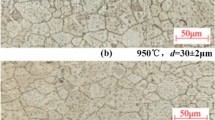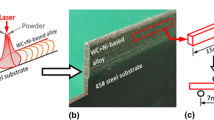Abstract
In applications requiring large specific surface area, ultrathin walls fabricated by selective laser melting (SLM) have attracted wide attention. Understanding that the geometric characteristics of ultrathin walls are affected by process parameters is an important topic. To investigate the influence of SLM process parameters on geometric morphology, interlayer banding characteristics, and defects of the AlSi10Mg ultrathin walls, based on the normalized processing map, the multi-layers and single-track SLM tests under different energy density and interlayer cooling conditions were implemented. The ultrathin walls with the width between 100 μm and 450 μm were successfully fabricated in the range of single-track energy density between 5 and 30, and their geometric morphology and interlayer banding characteristics are not significantly affected by the interlayer cooling time. Except that the height of thin walls does not change significantly with the process parameters, the width, penetration depth, and cross-sectional area of molten pool all have a power function decreasing relationship with the scanning speed, and all have a linearly increasing relationship with the laser power and single-track energy density, respectively. The macroscopic banding distance decreases linearly with the increase of laser power and single-track energy density and decreases exponentially with the decrease of scanning speed. When the single-track energy density is about 5 and 25, it is easier to obtain a more uniform banding distance close to the standard preset layer thickness under high power (≥ 300 W) with lower scanning speed (≤ 0.589746 m/s). The process parameter combination of high laser power (≥ 300 W) and low energy density (E* = 5) contributes to obtaining ultrathin-walled structures with the narrowest width of about 100 μm. Within the range of single-track energy density of 10 to 20, the use of appropriate laser power and scanning speed can be expected to avoid “necking,” “keyhole pore,” and “cracking” defects. This work provides guidance for choosing reasonable SLM process parameters when fabricating ultrathin walls in practical engineering applications.













Similar content being viewed by others
Data Availability
Not applicable.
Code availability
Not applicable.
References
Herzog D, Seyda V, Wycisk E, Emmelmann C (2016) Additive manufacturing of metals. Acta Mater 117:371–392
Bharath C, Shamanth V, Hemanth K (2020) Studies on mechanical behaviour of AlSi10Mg alloy produced by selective laser melting and A360 alloy by die casting. Mater Today Proc:S2214785320376732
Kempen K, Thijs L, Van Humbeeck J, Kruth JP (2015) Processing AlSi10Mg by selective laser melting: parameter optimization and material characterization. Mater Sci Technol 31:917–923
Kong D, Ni X, Dong C, Zhang L, Cheng M, Cheng X, Li X (2019) Anisotropy in the microstructure and mechanical property for the bulk and porous 316L stainless steel fabricated via selective laser melting. Mater Lett 235:1–5
Ataee A, Li Y, Brandt M, Wen C (2018) Ultrahigh-strength titanium gyroid scaffolds manufactured by selective laser melting (SLM) for bone implant applications. Acta Mater 158:354–368
Ho JY, Leong KC, Wong TN (2020) Additively-manufactured metallic porous lattice heat exchangers for air-side heat transfer enhancement. Int J Heat Mass Transf 150:119262
Leary M, Mazur M, Elambasseril J, McMillan M, Chirent T, Sun Y, Qian M, Easton M, Brandt M (2016) Selective laser melting (SLM) of AlSi12Mg lattice structures. Mater Des 98:344–357
Calignano F, Cattano G, Manfredi D (2018) Manufacturing of thin wall structures in AlSi10Mg alloy by laser powder bed fusion through process parameters. J Mater Process Technol 255:773–783
Thijs L, Kempen K, Kruth JP, Van Humbeeck J (2013) Fine-structured aluminium products with controllable texture by selective laser melting of pre-alloyed AlSi10Mg powder. Acta Mater 61:1809–1819
Anwar AB, Pham QC (2017) Selective laser melting of AlSi10Mg: Effects of scan direction, part placement and inert gas flow velocity on tensile strength. J Mater Process Technol 240:388–396
Trevisan F, Calignano F, Lorusso M, Pakkanen J, Aversa A, Ambrosio E, Lombardi M, Fino P, Manfredi D (2017) On the selective laser melting (SLM) of the AlSi10Mg alloy: process, microstructure, and mechanical properties. Materials 10:76
Read N, Wang W, Essa K, Attallah MM (2015) Selective laser melting of AlSi10Mg alloy: process optimisation and mechanical properties development. Mater Des 1980-2015 65:417–424
Zhang S, Wei Q, Cheng L, Li S, Shi Y (2014) Effects of scan line spacing on pore characteristics and mechanical properties of porous Ti6Al4V implants fabricated by selective laser melting. Mater Des 63:185–193
Yadroitsev I, Shishkovsky I, Bertrand P, Smurov I (2009) Manufacturing of fine-structured 3D porous filter elements by selective laser melting. Appl Surf Sci 255:5523–5527
Su X, Yang Y, Xiao D, Luo Z (2013) An investigation into direct fabrication of fine-structured components by selective laser melting. Int J Adv Manuf Technol 64:1231–1238
Abele E, Stoffregen HA, Kniepkamp M, Lang S, Hampe M (2015) Selective laser melting for manufacturing of thin-walled porous elements. J Mater Process Technol 215:114–122
Jiang J, Ma Y (2020) Path planning strategies to optimize accuracy, quality, build time and material use in additive manufacturing: a review. Micromachines 11:633
Kim DK, Hwang JH, Kim EY, Heo YU, Woo W, Choi SH (2017) Evaluation of the stress-strain relationship of constituent phases in AlSi10Mg alloy produced by selective laser melting using crystal plasticity FEM. J Alloys Compd 714:687–697
Wang D, Wu S, Bai Y, Lin H, Yang Y, Song C (2017) Characteristics of typical geometrical features shaped by selective laser melting. J Laser Appl 29:022007
Yadroitsev I, Smurov I (2010) Selective laser melting technology: from the single laser melted track stability to 3D parts of complex shape. Phys Procedia 5:551–560
Thijs L, Verhaeghe F, Craeghs T, Humbeeck JV, Kruth JP (2010) A study of the microstructural evolution during selective laser melting of Ti–6Al–4V. Acta Mater 58:3303–3312
Yadroitsev I, Krakhmalev P, Yadroitsava I, Johansson S, Smurov I (2013) Energy input effect on morphology and microstructure of selective laser melting single track from metallic powder. J Mater Process Technol 213:606–613
Thomas M, Baxter GJ, Todd I (2016) Normalised model-based processing diagrams for additive layer manufacture of engineering alloys. Acta Mater 108:26–35
Ion JC, Shercliff HR, Ashby MF (1992) Diagrams for laser materials processing. Acta Metall Mater 40:1539–1551
Aboulkhair NT, Everitt NM, Ashcroft I, Tuck C (2014) Reducing porosity in AlSi10Mg parts processed by selective laser melting. Addit Manuf 1–4:77–86
Kempen K, Thijs L, Van Humbeeck J, Kruth JP (2012) Mechanical properties of AlSi10Mg produced by selective laser melting. Phys Procedia 39:439–446
Li W, Li S, Liu J, Zhang A, Zhou Y, Wei Q, Yan C, Shi Y (2016) Effect of heat treatment on AlSi10Mg alloy fabricated by selective laser melting: microstructure evolution, mechanical properties and fracture mechanism. Mater Sci Eng A 663:116–125
Biffi CA, Fiocchi J, Bassani P, Paolino DS, Tridello A, Chiandussi G, Rossetto M, Tuissi A (2017) Microstructure and preliminary fatigue analysis on AlSi10Mg samples manufactured by SLM. Procedia Struct Integr 7:50–57
Yu T, Hyer H, Sohn Y, Bai Y, Wu D (2019) Structure-property relationship in high strength and lightweight AlSi10Mg microlattices fabricated by selective laser melting. Mater Des 182:108062
Brandl E, Heckenberger U, Holzinger V, Buchbinder D (2012) Additive manufactured AlSi10Mg samples using selective laser melting (SLM): microstructure, high cycle fatigue, and fracture behavior. Mater Des 34:159–169
Uzan NE, Shneck R, Yeheskel O, Frage N (2017) Fatigue of AlSi10Mg specimens fabricated by additive manufacturing selective laser melting (AM-SLM). Mater Sci Eng A 704:229–237
Leary M, Maconachie T, Sarker A, Faruque O, Brandt M (2019) Mechanical and thermal characterisation of AlSi10Mg SLM block support structures. Mater Des 183:108138
Silbernagel C, Ashcroft I, Dickens P, Galea M (2018) Electrical resistivity of additively manufactured AlSi10Mg for use in electric motors. Addit Manuf 21:395–403
Maamoun AH, Elbestawi M, Dosbaeva GK, Veldhuis SC (2018) Thermal post-processing of AlSi10Mg parts produced by selective laser melting using recycled powder. Addit Manuf 21:234–247
Kempen K, Thijs L, Yasa E, Badrossamay M, Verheecke W, Kruth JP (2011) Process optimization and microstructural analysis for selective laser melting of AlSi10Mg. Proc. Solid Free. Fabr. Symp. Texas, USA, In
Gusarov AV, Yadroitsev I, Bertrand P, Smurov I (2009) Model of radiation and heat transfer in laser-powder interaction zone at selective laser melting. J Heat Transf 131:70–79
Funding
This work was supported by China Postdoctoral Science Foundation (No. 2020M673587XB and No. 2020TQ0133), Yunnan Postdoctoral Research Found Project, Kunming University of Science and Technology Postdoctoral Academic Activities Foundation (No. 1323/109820190026), and Kunming University of Science and Technology Startup Research Grant for Distinguished Scholar (No. KKKP201751008).
Author information
Authors and Affiliations
Corresponding authors
Ethics declarations
Conflict of interest
The authors declare no competing interests.
Additional information
Publisher’s note
Springer Nature remains neutral with regard to jurisdictional claims in published maps and institutional affiliations.
Supplementary Information
ESM 1
(PDF 4.58 mb)
Rights and permissions
About this article
Cite this article
Lu, X., Li, M.V. & Yang, H. Geometric characteristics of AlSi10Mg ultrathin walls fabricated by selective laser melting with energy density and related process parameters. Int J Adv Manuf Technol 115, 3773–3790 (2021). https://doi.org/10.1007/s00170-021-07414-7
Received:
Accepted:
Published:
Issue Date:
DOI: https://doi.org/10.1007/s00170-021-07414-7




